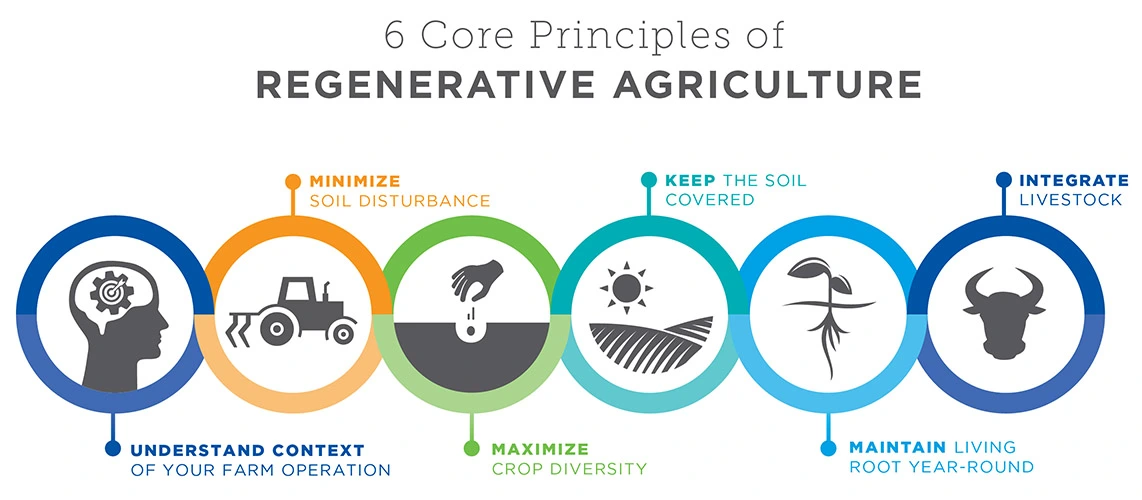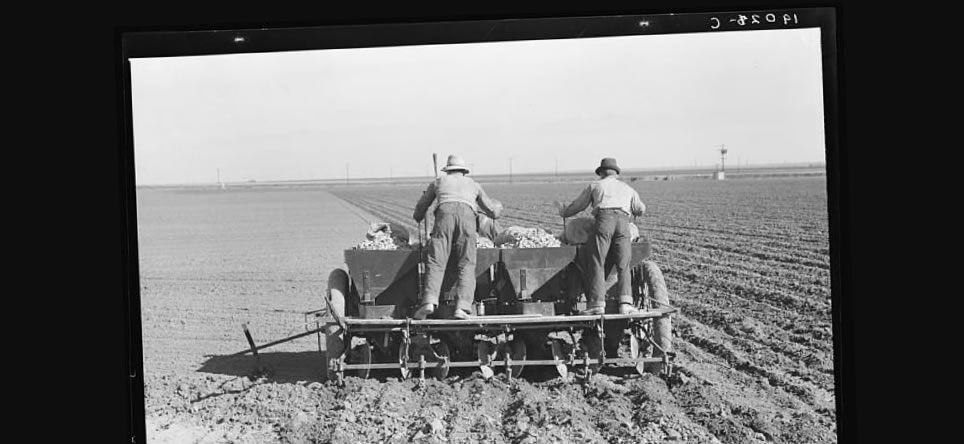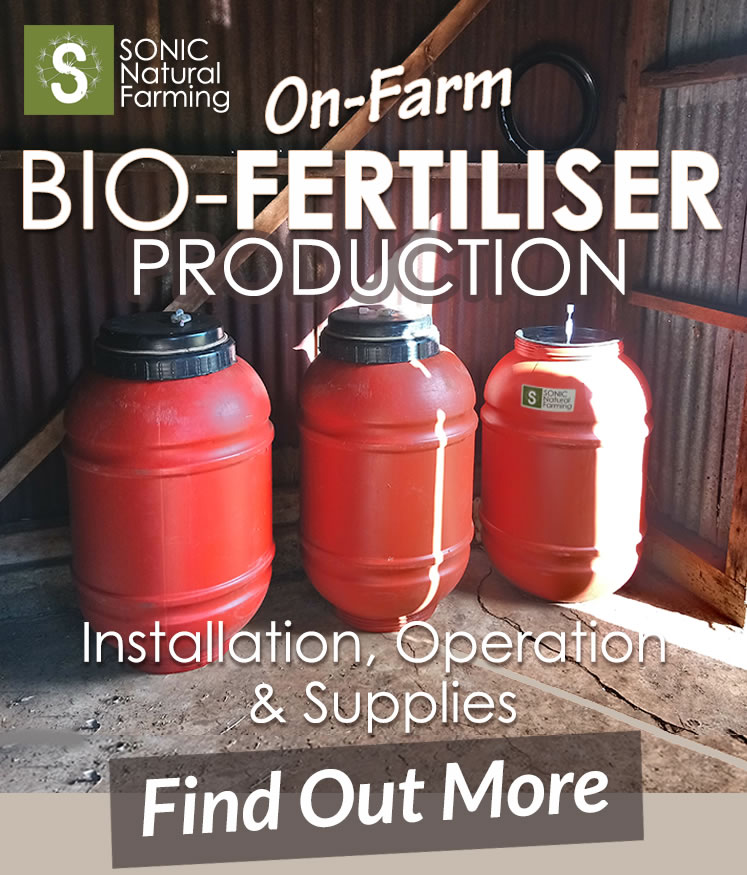Regenerative agriculture is an approach to farming and land management that focuses on rebuilding soil health and restoring degraded land. This holistic method utilises a variety of practices that work in harmony to improve the overall ecosystem.
By implementing these techniques, regenerative agriculture is able to sequester carbon, improve water retention, increase biodiversity, and enhance the overall fertility of the soil. This leads to more resilient and productive farmland that can better withstand environmental stresses like drought, flooding, and erosion.
Regenerative agriculture represents a shift away from the conventional industrial model that has degraded soils worldwide. Its emphasis on working with natural processes, rather than against them, makes it a promising solution for sustainable food production in the years to come.
Where did Regenerative Agriculture Begin?
Using natural farming methods to grow food has been around since man first ‘mingled’ with nature and required food to sustain himself, his family, and his community.
After innovations occured in plant nutrition, around the 19th century, an agricultural industry developed around synthetically created fertilisers. Since then, agriculture has taken a deep dive into chemical inputs, and what is now known as, conventional farming.
In response, however, to concerns about the environmental impacts of modern agricultural practices, natural farming and regenerative agricultural movements, coupled with a ‘sustainable’ mindset around farming, have begun to re-emerge.

What are the Benefits of using Regenerative Practices?
Regenerative agriculture is a holistic approach to natural farming and land management that focusses on soil biodiversity and increasing natural resilience, which is achieved through mimicking nature and natural processes.
Some of the key practices of regenerative agriculture include:
– Minimal soil disturbance through reduced or no-till farming
– Maintaining living plant roots in the soil, year-round
– Incorporating cover crops and diverse crop rotations
– Integrating livestock grazing to mimic natural ecosystems
– Avoiding the use of synthetic fertilisers and pesticides
Furthermore, regenerative agricultural practices aim to restore and enhance the health of living ecosystems.
Regenerative agriculture goes beyond sustainable practices. Sustainability sustains the status quo, regenerative agriculture offers nature the power to regenerate or restore the eco-system and to actively replenish and regenerate the soil, water, and the biodiversity.
Here are 5 core principles that guide regenerative agriculture:
1. Soil Health
Regenerative agriculture focuses on building healthy soils.
It uses practices such as cover cropping, crop rotation, minimal tillage, and the use of compost, or organic matter, and natural inputs such as fish hydrolysate and seaweed biological fertiliser. These practices help improve soil structure, increase nutrient availability, and promote beneficial microbial activity in the soil.
2. Biodiversity
Encouraging biodiversity is another key principle of natural farming and regenerative agriculture.
By promoting diverse plant species and habitats on farm, it supports a wide range of beneficial insects, birds, and other wildlife that contribute to pest control and pollination.
3. Water Management
Efficient water management is crucial in regenerative agriculture.
Practices like contour plowing or terracing help reduce erosion and retain water in the soil for longer periods. Additionally, implementing irrigation into natural farming systems help minimise water waste and can further conserve this precious resource.
4. Carbon Sequestration
Regenerative agriculture plays a significant role in mitigating climate extremes by sequestering carbon dioxide from the atmosphere into the soil.
By increasing organic matter content through practices like cover cropping or agroforestry, natural farming practices can enhance carbon storage capacity, while reducing greenhouse gas emissions.
5. Community Engagement
Regenerative agriculture emphasises community involvement by fostering relationships between farmers, consumers, local businesses, and organisations.
This collaborative approach helps create resilient food systems that support local economies while providing healthier food choices for communities.
By adhering to these core principles of natural farming and regenerative agriculture, farmers can not only improve their own livelihoods but also contribute to environmental sustainability for future generations.

Some other approaches related to regenerative agriculture include;
Korean Natural Farming (KNF). Originating from South Korea, KNF emphasises the use of indigenous microorganisms and natural inputs to enhance soil fertility and plant health. This method promotes self-sufficiency in farming by utilising locally available resources.
Korean Natural Farming
Originally created from the need for low cost, self-sufficient farming, Korean Natural Farming utilises a process of collecting indigenous beneficial soil microorganisms and using them to produce effective inputs to enhance soil fertility.
Korean Natural Farming began around 1960 with a goal of using what is available on the land to give back to the soil, and in doing so, strengthening plant growth without the use of chemicals, fungicides or synthetic fertilisers.
External Links: Korean Natural Farming – Video List
Biodynamics
Biodynamics is closely related to natural farming and regenerative agriculture. Developed by Rudolf Steiner in the early 20th century, biodynamics incorporates spiritual and esoteric principles into farming practices. It involves working with lunar cycles, compost preparations, and integrating livestock into agricultural systems.
Biodynamics is often cited as being the first modern method or natural farming system that works with, not against, nature, and was one of the first organic farming movements. Biodynamics treats soil fertility, plant growth, and livestock care as ecologically interrelated tasks.
External Links: Biodynamic Farming – Videos
Syntropic Farming
Syntropic farming, also known as agroforestry or analog forestry, is a regenerative approach that mimics natural forest ecosystems. It involves planting diverse crops in layers or guilds to create a balanced ecosystem that supports mutualistic relationships among plants, animals, and microorganisms.
Growing a diversity of vegetation that requires strategic planning, Syntropic Farming is based on natural ecological succession and synchronised pruning practices. Syntropic farming also mimics nature by way of assisting healthy soil biology through plant diversity and using natural mulch (chop and drop) for ground cover.
External Links: Syntropic Farming – Videos
What are the Common Themes between these Natural Farming Approaches?
There are many common themes with all natural and regenerative farming practices, which include;
1. Advancing Beneficial Soil Microbes
One commonality is an acknowledgement of living organisms in the soil that benefit the plants growth, strength, and nutrient density.
2. Working ‘With’ Nature
Another common theme with all natural farming is the idea of working with nature, rather than against it. This means using natural processes and ecosystems to our advantage, rather than trying to control them.
For example, natural farmers using regenerative agriculture would use mixed-species cover crops, and rotational grazing to improve soil health, rather than relying on synthetic fertilisers and pesticides to boost growth, at the cost of losing soil biology. Each one tends to mimic nature as much as possible in their farming systems, using natural inputs to maintain soil biology.
3. Diversity, Diversity, Diversity
All natural farming systems tend to focus on creating a diversified farm system, which includes a variety of different crops and animals. This diversification helps to create a more resilient farm system that is better able to withstand pest and disease pressures.
Overall, all natural farming practices and regenerative agricultural systems are about working with nature to create a more sustainable and environmentally friendly way of producing nutrient dense food.
Build Soil. Diversify. Mimick Nature. No Chemicals. Regenerate.
Applying regenerative agriculture and natural farming principals on your land is about knowing your land. But, more importantly, it’s about knowing your soil.
By focusing on soil fertility, we can enable the most incredible biological networks to develop. And, those networks do all the work that a lab scientist is ‘trying’ to do, but for free.
Beneficial microorganisms are primed to know which minerals to deliver, when, and how much. Just as nature intended. These intelligent creatures facilitate nutrient acquisition and cycling. Beneficial soil microorganisms set the foundation for the growth of nutrient dense, robust, and resilient crops.
“As consumers become more aware of the importance of sustainable practices, regenerative agriculture is gaining momentum and is expected to become the norm within the next few decades.” Above video by RCS Australia. RCS Australia is a leading provider of regenerative agriculture training and consulting services, focused on improving soil health, sustainability, and farm profitability through holistic management practices.

“Regenerative agriculture management systems have so much more to offer than contemporary systems: higher yields, improved nutritional integrity, disease resistance, insect resistance, reduced input costs, increased profitability, reduced climactic risk, regenerating ecosystems, improved public health outcomes, and so much more.”
– John Kempf
John Kempf is an American regenerative farming advocate and founder of Advancing Eco Agriculture, a company dedicated to promoting soil health, plant nutrition, and regenerative agriculture practices. Through his work, he emphasises the importance of holistic farming systems to improve crop yields, resilience, and environmental sustainability.
Key takeaways from Kempf’s approach is:
1. Treat soil as a biology lab
2. Create the needed physical environment
3. Add biology that has been lost
4. Feed it with mulch or cover crops
5. Provide balanced mineral nutrition
6. Possibly speed up the system with foliars
7. Avoid adding excess minerals
For more information on John Kempf – Simple and Comprehensive Fertility Management see video – Fertility Management – John Kempf
RELATED EXTERNAL LINKS
Regenerative Farming – Informational Videos (Youtube)
What are Beneficial Soil Microbes?

















